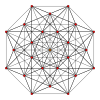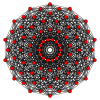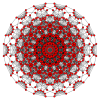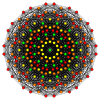Uniform 7-polytope
In seven-dimensional geometry, a 7-polytope is a polytope contained by 6-polytope facets. Each 5-polytope ridge being shared by exactly two 6-polytope facets.
A uniform 7-polytope is one whose symmetry group is transitive on vertices and whose facets are uniform 6-polytopes.
Regular 7-polytopes[edit]
Regular 7-polytopes are represented by the Schläfli symbol {p,q,r,s,t,u} with u {p,q,r,s,t} 6-polytopes facets around each 4-face.
There are exactly three such convex regular 7-polytopes:
- {3,3,3,3,3,3} - 7-simplex
- {4,3,3,3,3,3} - 7-cube
- {3,3,3,3,3,4} - 7-orthoplex
There are no nonconvex regular 7-polytopes.
Characteristics[edit]
The topology of any given 7-polytope is defined by its Betti numbers and torsion coefficients.[1]
The value of the Euler characteristic used to characterise polyhedra does not generalize usefully to higher dimensions, whatever their underlying topology. This inadequacy of the Euler characteristic to reliably distinguish between different topologies in higher dimensions led to the discovery of the more sophisticated Betti numbers.[1]
Similarly, the notion of orientability of a polyhedron is insufficient to characterise the surface twistings of toroidal polytopes, and this led to the use of torsion coefficients.[1]
Uniform 7-polytopes by fundamental Coxeter groups[edit]
Uniform 7-polytopes with reflective symmetry can be generated by these four Coxeter groups, represented by permutations of rings of the Coxeter-Dynkin diagrams:
| # | Coxeter group | Regular and semiregular forms | Uniform count | ||
|---|---|---|---|---|---|
| 1 | A7 | [36] |
| 71 | |
| 2 | B7 | [4,35] |
| 127 + 32 | |
| 3 | D7 | [33,1,1] |
| 95 (0 unique) | |
| 4 | E7 | [33,2,1] | 127 | ||
| Prismatic finite Coxeter groups | |||||||||||
|---|---|---|---|---|---|---|---|---|---|---|---|
| # | Coxeter group | Coxeter diagram | |||||||||
| 6+1 | |||||||||||
| 1 | A6A1 | [35]×[ ] | |||||||||
| 2 | BC6A1 | [4,34]×[ ] | |||||||||
| 3 | D6A1 | [33,1,1]×[ ] | |||||||||
| 4 | E6A1 | [32,2,1]×[ ] | |||||||||
| 5+2 | |||||||||||
| 1 | A5I2(p) | [3,3,3]×[p] | |||||||||
| 2 | BC5I2(p) | [4,3,3]×[p] | |||||||||
| 3 | D5I2(p) | [32,1,1]×[p] | |||||||||
| 5+1+1 | |||||||||||
| 1 | A5A12 | [3,3,3]×[ ]2 | |||||||||
| 2 | BC5A12 | [4,3,3]×[ ]2 | |||||||||
| 3 | D5A12 | [32,1,1]×[ ]2 | |||||||||
| 4+3 | |||||||||||
| 1 | A4A3 | [3,3,3]×[3,3] | |||||||||
| 2 | A4B3 | [3,3,3]×[4,3] | |||||||||
| 3 | A4H3 | [3,3,3]×[5,3] | |||||||||
| 4 | BC4A3 | [4,3,3]×[3,3] | |||||||||
| 5 | BC4B3 | [4,3,3]×[4,3] | |||||||||
| 6 | BC4H3 | [4,3,3]×[5,3] | |||||||||
| 7 | H4A3 | [5,3,3]×[3,3] | |||||||||
| 8 | H4B3 | [5,3,3]×[4,3] | |||||||||
| 9 | H4H3 | [5,3,3]×[5,3] | |||||||||
| 10 | F4A3 | [3,4,3]×[3,3] | |||||||||
| 11 | F4B3 | [3,4,3]×[4,3] | |||||||||
| 12 | F4H3 | [3,4,3]×[5,3] | |||||||||
| 13 | D4A3 | [31,1,1]×[3,3] | |||||||||
| 14 | D4B3 | [31,1,1]×[4,3] | |||||||||
| 15 | D4H3 | [31,1,1]×[5,3] | |||||||||
| 4+2+1 | |||||||||||
| 1 | A4I2(p)A1 | [3,3,3]×[p]×[ ] | |||||||||
| 2 | BC4I2(p)A1 | [4,3,3]×[p]×[ ] | |||||||||
| 3 | F4I2(p)A1 | [3,4,3]×[p]×[ ] | |||||||||
| 4 | H4I2(p)A1 | [5,3,3]×[p]×[ ] | |||||||||
| 5 | D4I2(p)A1 | [31,1,1]×[p]×[ ] | |||||||||
| 4+1+1+1 | |||||||||||
| 1 | A4A13 | [3,3,3]×[ ]3 | |||||||||
| 2 | BC4A13 | [4,3,3]×[ ]3 | |||||||||
| 3 | F4A13 | [3,4,3]×[ ]3 | |||||||||
| 4 | H4A13 | [5,3,3]×[ ]3 | |||||||||
| 5 | D4A13 | [31,1,1]×[ ]3 | |||||||||
| 3+3+1 | |||||||||||
| 1 | A3A3A1 | [3,3]×[3,3]×[ ] | |||||||||
| 2 | A3B3A1 | [3,3]×[4,3]×[ ] | |||||||||
| 3 | A3H3A1 | [3,3]×[5,3]×[ ] | |||||||||
| 4 | BC3B3A1 | [4,3]×[4,3]×[ ] | |||||||||
| 5 | BC3H3A1 | [4,3]×[5,3]×[ ] | |||||||||
| 6 | H3A3A1 | [5,3]×[5,3]×[ ] | |||||||||
| 3+2+2 | |||||||||||
| 1 | A3I2(p)I2(q) | [3,3]×[p]×[q] | |||||||||
| 2 | BC3I2(p)I2(q) | [4,3]×[p]×[q] | |||||||||
| 3 | H3I2(p)I2(q) | [5,3]×[p]×[q] | |||||||||
| 3+2+1+1 | |||||||||||
| 1 | A3I2(p)A12 | [3,3]×[p]×[ ]2 | |||||||||
| 2 | BC3I2(p)A12 | [4,3]×[p]×[ ]2 | |||||||||
| 3 | H3I2(p)A12 | [5,3]×[p]×[ ]2 | |||||||||
| 3+1+1+1+1 | |||||||||||
| 1 | A3A14 | [3,3]×[ ]4 | |||||||||
| 2 | BC3A14 | [4,3]×[ ]4 | |||||||||
| 3 | H3A14 | [5,3]×[ ]4 | |||||||||
| 2+2+2+1 | |||||||||||
| 1 | I2(p)I2(q)I2(r)A1 | [p]×[q]×[r]×[ ] | |||||||||
| 2+2+1+1+1 | |||||||||||
| 1 | I2(p)I2(q)A13 | [p]×[q]×[ ]3 | |||||||||
| 2+1+1+1+1+1 | |||||||||||
| 1 | I2(p)A15 | [p]×[ ]5 | |||||||||
| 1+1+1+1+1+1+1 | |||||||||||
| 1 | A17 | [ ]7 | |||||||||
The A7 family[edit]
The A7 family has symmetry of order 40320 (8 factorial).
There are 71 (64+8-1) forms based on all permutations of the Coxeter-Dynkin diagrams with one or more rings. All 71 are enumerated below. Norman Johnson's truncation names are given. Bowers names and acronym are also given for cross-referencing.
See also a list of A7 polytopes for symmetric Coxeter plane graphs of these polytopes.
| A7 uniform polytopes | |||||||||||
|---|---|---|---|---|---|---|---|---|---|---|---|
| # | Coxeter-Dynkin diagram | Truncation indices | Johnson name Bowers name (and acronym) | Basepoint | Element counts | ||||||
| 6 | 5 | 4 | 3 | 2 | 1 | 0 | |||||
| 1 | t0 | 7-simplex (oca) | (0,0,0,0,0,0,0,1) | 8 | 28 | 56 | 70 | 56 | 28 | 8 | |
| 2 | t1 | Rectified 7-simplex (roc) | (0,0,0,0,0,0,1,1) | 16 | 84 | 224 | 350 | 336 | 168 | 28 | |
| 3 | t2 | Birectified 7-simplex (broc) | (0,0,0,0,0,1,1,1) | 16 | 112 | 392 | 770 | 840 | 420 | 56 | |
| 4 | t3 | Trirectified 7-simplex (he) | (0,0,0,0,1,1,1,1) | 16 | 112 | 448 | 980 | 1120 | 560 | 70 | |
| 5 | t0,1 | Truncated 7-simplex (toc) | (0,0,0,0,0,0,1,2) | 16 | 84 | 224 | 350 | 336 | 196 | 56 | |
| 6 | t0,2 | Cantellated 7-simplex (saro) | (0,0,0,0,0,1,1,2) | 44 | 308 | 980 | 1750 | 1876 | 1008 | 168 | |
| 7 | t1,2 | Bitruncated 7-simplex (bittoc) | (0,0,0,0,0,1,2,2) | 588 | 168 | ||||||
| 8 | t0,3 | Runcinated 7-simplex (spo) | (0,0,0,0,1,1,1,2) | 100 | 756 | 2548 | 4830 | 4760 | 2100 | 280 | |
| 9 | t1,3 | Bicantellated 7-simplex (sabro) | (0,0,0,0,1,1,2,2) | 2520 | 420 | ||||||
| 10 | t2,3 | Tritruncated 7-simplex (tattoc) | (0,0,0,0,1,2,2,2) | 980 | 280 | ||||||
| 11 | t0,4 | Stericated 7-simplex (sco) | (0,0,0,1,1,1,1,2) | 2240 | 280 | ||||||
| 12 | t1,4 | Biruncinated 7-simplex (sibpo) | (0,0,0,1,1,1,2,2) | 4200 | 560 | ||||||
| 13 | t2,4 | Tricantellated 7-simplex (stiroh) | (0,0,0,1,1,2,2,2) | 3360 | 560 | ||||||
| 14 | t0,5 | Pentellated 7-simplex (seto) | (0,0,1,1,1,1,1,2) | 1260 | 168 | ||||||
| 15 | t1,5 | Bistericated 7-simplex (sabach) | (0,0,1,1,1,1,2,2) | 3360 | 420 | ||||||
| 16 | t0,6 | Hexicated 7-simplex (suph) | (0,1,1,1,1,1,1,2) | 336 | 56 | ||||||
| 17 | t0,1,2 | Cantitruncated 7-simplex (garo) | (0,0,0,0,0,1,2,3) | 1176 | 336 | ||||||
| 18 | t0,1,3 | Runcitruncated 7-simplex (patto) | (0,0,0,0,1,1,2,3) | 4620 | 840 | ||||||
| 19 | t0,2,3 | Runcicantellated 7-simplex (paro) | (0,0,0,0,1,2,2,3) | 3360 | 840 | ||||||
| 20 | t1,2,3 | Bicantitruncated 7-simplex (gabro) | (0,0,0,0,1,2,3,3) | 2940 | 840 | ||||||
| 21 | t0,1,4 | Steritruncated 7-simplex (cato) | (0,0,0,1,1,1,2,3) | 7280 | 1120 | ||||||
| 22 | t0,2,4 | Stericantellated 7-simplex (caro) | (0,0,0,1,1,2,2,3) | 10080 | 1680 | ||||||
| 23 | t1,2,4 | Biruncitruncated 7-simplex (bipto) | (0,0,0,1,1,2,3,3) | 8400 | 1680 | ||||||
| 24 | t0,3,4 | Steriruncinated 7-simplex (cepo) | (0,0,0,1,2,2,2,3) | 5040 | 1120 | ||||||
| 25 | t1,3,4 | Biruncicantellated 7-simplex (bipro) | (0,0,0,1,2,2,3,3) | 7560 | 1680 | ||||||
| 26 | t2,3,4 | Tricantitruncated 7-simplex (gatroh) | (0,0,0,1,2,3,3,3) | 3920 | 1120 | ||||||
| 27 | t0,1,5 | Pentitruncated 7-simplex (teto) | (0,0,1,1,1,1,2,3) | 5460 | 840 | ||||||
| 28 | t0,2,5 | Penticantellated 7-simplex (tero) | (0,0,1,1,1,2,2,3) | 11760 | 1680 | ||||||
| 29 | t1,2,5 | Bisteritruncated 7-simplex (bacto) | (0,0,1,1,1,2,3,3) | 9240 | 1680 | ||||||
| 30 | t0,3,5 | Pentiruncinated 7-simplex (tepo) | (0,0,1,1,2,2,2,3) | 10920 | 1680 | ||||||
| 31 | t1,3,5 | Bistericantellated 7-simplex (bacroh) | (0,0,1,1,2,2,3,3) | 15120 | 2520 | ||||||
| 32 | t0,4,5 | Pentistericated 7-simplex (teco) | (0,0,1,2,2,2,2,3) | 4200 | 840 | ||||||
| 33 | t0,1,6 | Hexitruncated 7-simplex (puto) | (0,1,1,1,1,1,2,3) | 1848 | 336 | ||||||
| 34 | t0,2,6 | Hexicantellated 7-simplex (puro) | (0,1,1,1,1,2,2,3) | 5880 | 840 | ||||||
| 35 | t0,3,6 | Hexiruncinated 7-simplex (puph) | (0,1,1,1,2,2,2,3) | 8400 | 1120 | ||||||
| 36 | t0,1,2,3 | Runcicantitruncated 7-simplex (gapo) | (0,0,0,0,1,2,3,4) | 5880 | 1680 | ||||||
| 37 | t0,1,2,4 | Stericantitruncated 7-simplex (cagro) | (0,0,0,1,1,2,3,4) | 16800 | 3360 | ||||||
| 38 | t0,1,3,4 | Steriruncitruncated 7-simplex (capto) | (0,0,0,1,2,2,3,4) | 13440 | 3360 | ||||||
| 39 | t0,2,3,4 | Steriruncicantellated 7-simplex (capro) | (0,0,0,1,2,3,3,4) | 13440 | 3360 | ||||||
| 40 | t1,2,3,4 | Biruncicantitruncated 7-simplex (gibpo) | (0,0,0,1,2,3,4,4) | 11760 | 3360 | ||||||
| 41 | t0,1,2,5 | Penticantitruncated 7-simplex (tegro) | (0,0,1,1,1,2,3,4) | 18480 | 3360 | ||||||
| 42 | t0,1,3,5 | Pentiruncitruncated 7-simplex (tapto) | (0,0,1,1,2,2,3,4) | 27720 | 5040 | ||||||
| 43 | t0,2,3,5 | Pentiruncicantellated 7-simplex (tapro) | (0,0,1,1,2,3,3,4) | 25200 | 5040 | ||||||
| 44 | t1,2,3,5 | Bistericantitruncated 7-simplex (bacogro) | (0,0,1,1,2,3,4,4) | 22680 | 5040 | ||||||
| 45 | t0,1,4,5 | Pentisteritruncated 7-simplex (tecto) | (0,0,1,2,2,2,3,4) | 15120 | 3360 | ||||||
| 46 | t0,2,4,5 | Pentistericantellated 7-simplex (tecro) | (0,0,1,2,2,3,3,4) | 25200 | 5040 | ||||||
| 47 | t1,2,4,5 | Bisteriruncitruncated 7-simplex (bicpath) | (0,0,1,2,2,3,4,4) | 20160 | 5040 | ||||||
| 48 | t0,3,4,5 | Pentisteriruncinated 7-simplex (tacpo) | (0,0,1,2,3,3,3,4) | 15120 | 3360 | ||||||
| 49 | t0,1,2,6 | Hexicantitruncated 7-simplex (pugro) | (0,1,1,1,1,2,3,4) | 8400 | 1680 | ||||||
| 50 | t0,1,3,6 | Hexiruncitruncated 7-simplex (pugato) | (0,1,1,1,2,2,3,4) | 20160 | 3360 | ||||||
| 51 | t0,2,3,6 | Hexiruncicantellated 7-simplex (pugro) | (0,1,1,1,2,3,3,4) | 16800 | 3360 | ||||||
| 52 | t0,1,4,6 | Hexisteritruncated 7-simplex (pucto) | (0,1,1,2,2,2,3,4) | 20160 | 3360 | ||||||
| 53 | t0,2,4,6 | Hexistericantellated 7-simplex (pucroh) | (0,1,1,2,2,3,3,4) | 30240 | 5040 | ||||||
| 54 | t0,1,5,6 | Hexipentitruncated 7-simplex (putath) | (0,1,2,2,2,2,3,4) | 8400 | 1680 | ||||||
| 55 | t0,1,2,3,4 | Steriruncicantitruncated 7-simplex (gecco) | (0,0,0,1,2,3,4,5) | 23520 | 6720 | ||||||
| 56 | t0,1,2,3,5 | Pentiruncicantitruncated 7-simplex (tegapo) | (0,0,1,1,2,3,4,5) | 45360 | 10080 | ||||||
| 57 | t0,1,2,4,5 | Pentistericantitruncated 7-simplex (tecagro) | (0,0,1,2,2,3,4,5) | 40320 | 10080 | ||||||
| 58 | t0,1,3,4,5 | Pentisteriruncitruncated 7-simplex (tacpeto) | (0,0,1,2,3,3,4,5) | 40320 | 10080 | ||||||
| 59 | t0,2,3,4,5 | Pentisteriruncicantellated 7-simplex (tacpro) | (0,0,1,2,3,4,4,5) | 40320 | 10080 | ||||||
| 60 | t1,2,3,4,5 | Bisteriruncicantitruncated 7-simplex (gabach) | (0,0,1,2,3,4,5,5) | 35280 | 10080 | ||||||
| 61 | t0,1,2,3,6 | Hexiruncicantitruncated 7-simplex (pugopo) | (0,1,1,1,2,3,4,5) | 30240 | 6720 | ||||||
| 62 | t0,1,2,4,6 | Hexistericantitruncated 7-simplex (pucagro) | (0,1,1,2,2,3,4,5) | 50400 | 10080 | ||||||
| 63 | t0,1,3,4,6 | Hexisteriruncitruncated 7-simplex (pucpato) | (0,1,1,2,3,3,4,5) | 45360 | 10080 | ||||||
| 64 | t0,2,3,4,6 | Hexisteriruncicantellated 7-simplex (pucproh) | (0,1,1,2,3,4,4,5) | 45360 | 10080 | ||||||
| 65 | t0,1,2,5,6 | Hexipenticantitruncated 7-simplex (putagro) | (0,1,2,2,2,3,4,5) | 30240 | 6720 | ||||||
| 66 | t0,1,3,5,6 | Hexipentiruncitruncated 7-simplex (putpath) | (0,1,2,2,3,3,4,5) | 50400 | 10080 | ||||||
| 67 | t0,1,2,3,4,5 | Pentisteriruncicantitruncated 7-simplex (geto) | (0,0,1,2,3,4,5,6) | 70560 | 20160 | ||||||
| 68 | t0,1,2,3,4,6 | Hexisteriruncicantitruncated 7-simplex (pugaco) | (0,1,1,2,3,4,5,6) | 80640 | 20160 | ||||||
| 69 | t0,1,2,3,5,6 | Hexipentiruncicantitruncated 7-simplex (putgapo) | (0,1,2,2,3,4,5,6) | 80640 | 20160 | ||||||
| 70 | t0,1,2,4,5,6 | Hexipentistericantitruncated 7-simplex (putcagroh) | (0,1,2,3,3,4,5,6) | 80640 | 20160 | ||||||
| 71 | t0,1,2,3,4,5,6 | Omnitruncated 7-simplex (guph) | (0,1,2,3,4,5,6,7) | 141120 | 40320 | ||||||
The B7 family[edit]
The B7 family has symmetry of order 645120 (7 factorial x 27).
There are 127 forms based on all permutations of the Coxeter-Dynkin diagrams with one or more rings. Johnson and Bowers names.
See also a list of B7 polytopes for symmetric Coxeter plane graphs of these polytopes.
| B7 uniform polytopes | |||||||||||
|---|---|---|---|---|---|---|---|---|---|---|---|
| # | Coxeter-Dynkin diagram t-notation | Name (BSA) | Base point | Element counts | |||||||
| 6 | 5 | 4 | 3 | 2 | 1 | 0 | |||||
| 1 | t0{3,3,3,3,3,4} | 7-orthoplex (zee) | (0,0,0,0,0,0,1)√2 | 128 | 448 | 672 | 560 | 280 | 84 | 14 | |
| 2 | t1{3,3,3,3,3,4} | Rectified 7-orthoplex (rez) | (0,0,0,0,0,1,1)√2 | 142 | 1344 | 3360 | 3920 | 2520 | 840 | 84 | |
| 3 | t2{3,3,3,3,3,4} | Birectified 7-orthoplex (barz) | (0,0,0,0,1,1,1)√2 | 142 | 1428 | 6048 | 10640 | 8960 | 3360 | 280 | |
| 4 | t3{4,3,3,3,3,3} | Trirectified 7-cube (sez) | (0,0,0,1,1,1,1)√2 | 142 | 1428 | 6328 | 14560 | 15680 | 6720 | 560 | |
| 5 | t2{4,3,3,3,3,3} | Birectified 7-cube (bersa) | (0,0,1,1,1,1,1)√2 | 142 | 1428 | 5656 | 11760 | 13440 | 6720 | 672 | |
| 6 | t1{4,3,3,3,3,3} | Rectified 7-cube (rasa) | (0,1,1,1,1,1,1)√2 | 142 | 980 | 2968 | 5040 | 5152 | 2688 | 448 | |
| 7 | t0{4,3,3,3,3,3} | 7-cube (hept) | (0,0,0,0,0,0,0)√2 + (1,1,1,1,1,1,1) | 14 | 84 | 280 | 560 | 672 | 448 | 128 | |
| 8 | t0,1{3,3,3,3,3,4} | Truncated 7-orthoplex (Taz) | (0,0,0,0,0,1,2)√2 | 142 | 1344 | 3360 | 4760 | 2520 | 924 | 168 | |
| 9 | t0,2{3,3,3,3,3,4} | Cantellated 7-orthoplex (Sarz) | (0,0,0,0,1,1,2)√2 | 226 | 4200 | 15456 | 24080 | 19320 | 7560 | 840 | |
| 10 | t1,2{3,3,3,3,3,4} | Bitruncated 7-orthoplex (Botaz) | (0,0,0,0,1,2,2)√2 | 4200 | 840 | ||||||
| 11 | t0,3{3,3,3,3,3,4} | Runcinated 7-orthoplex (Spaz) | (0,0,0,1,1,1,2)√2 | 23520 | 2240 | ||||||
| 12 | t1,3{3,3,3,3,3,4} | Bicantellated 7-orthoplex (Sebraz) | (0,0,0,1,1,2,2)√2 | 26880 | 3360 | ||||||
| 13 | t2,3{3,3,3,3,3,4} | Tritruncated 7-orthoplex (Totaz) | (0,0,0,1,2,2,2)√2 | 10080 | 2240 | ||||||
| 14 | t0,4{3,3,3,3,3,4} | Stericated 7-orthoplex (Scaz) | (0,0,1,1,1,1,2)√2 | 33600 | 3360 | ||||||
| 15 | t1,4{3,3,3,3,3,4} | Biruncinated 7-orthoplex (Sibpaz) | (0,0,1,1,1,2,2)√2 | 60480 | 6720 | ||||||
| 16 | t2,4{4,3,3,3,3,3} | Tricantellated 7-cube (Strasaz) | (0,0,1,1,2,2,2)√2 | 47040 | 6720 | ||||||
| 17 | t2,3{4,3,3,3,3,3} | Tritruncated 7-cube (Tatsa) | (0,0,1,2,2,2,2)√2 | 13440 | 3360 | ||||||
| 18 | |||||||||||


 French
French Deutsch
Deutsch






























